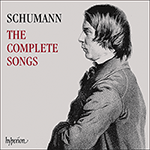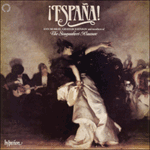This work is the sequel to the Spanisches Liederspiel Op 74. By his own admission (letter to Kistner, 30 April 1849) Schumann had found the rejected items from that cycle (Nos 5 and 9 of the Spanisches Liederspiel) ‘charming’. The existence of two such stray pieces would have been an incentive to find another framework for them; and of course there were further poems from the Volkslieder und Romanzen der Spanier which had caught his eye. Thus songs that had been composed in March 1849 were supplemented by music composed in November of the same year. In what he termed ‘a cycle for one and more voices’ he was proud of himself for having found a new vehicle for vocal music, a small riposte to the overweening experiments of Wagner which threatened to engulf the world of music as Schumann knew it. The political upheavals of 1848 were a watershed which showed that a conservative position alone was insufficient to safeguard the values of the past. Schumann was sympathetic to the rhetoric of the left, but he was a conservative in other ways. For much of his maturity Schumann aimed to counter Wagnerian developments with new ideas of his own, even if they were modest by comparison: one thinks of the Scenen aus Goethe’s Faust – a work acknowledged at last as truly innovative – which proposes an alternative to opera. The three Liederspiele of 1849 (the Rückert Minnespiel was the other) attempt to promote a new order in song-recital terms. It is fun to think of them as a sort of democratic singers’ co-operative, chamber-music works which call on singers to forget their star status in the interests of their colleagues. Another new touch in this cycle (a modification of the format for Op 74) was to take away a single pianist’s possession of the keyboard; even this now had to be shared with someone else as a piano duet. A version for solo accompaniment was published only in 1860.
The Spanische Liebeslieder is essentially a work in G minor (six out of ten numbers) with episodes in the relative major (two items in B flat major), the submediant (E flat major) and a large central panel in the dominant (the Romanze in D major) which acts as a pivotal point between the two halves of the cycle and ushers in the dance in G minor which introduces Part Two. Op 138 is more even-handed than Op 74 in terms of allocations of songs to individual singers: the soprano, alto [recte mezzo soprano] and bass [recte baritone] each have a solo; the two tenor soli are shorter and written as if mirror-image halves of a single song; there is a duet each for the women and the men, and one concluding quartet. The tonal scheme and the casting makes the Spanisches Liebeslieder a neater and more consciously constructed cycle than the earlier Spanisches Liederspiel.
from notes by Graham Johnson © 2002
Voici ici le Schumann de 1840 et ses hispanisations touristiques de
Der Hidalgo. Le choix du compositeur, un cycle souple pour quatre voix avec piano (op. 74) avec quelques solos, quelques duos et quelques ensembles à quatre voix, suivi d’une autre œuvre dans le même style pour quatre voix avec piano à quatre mains (op. 138), aura une influence considérable sur les compositeurs ultérieurs—surtout dans les célèbres
Liebeslieder Waltzes de Brahms pour voix et piano à quatre mains qui seront modelées sur l’exemple de Schumann. Les
Liebeslieder op. 138 comportent deux solos instrumentaux pour les pianistes. Dans cette œuvre, le beau solo de baryton
Flutenreicher Ebro est inoubliable et la passion du duo
Bedeckt mich mit Blumen contraste avec la langueur du lied que Wolf a composé sur le même texte. Les deux solos charmeurs de ténor qui taquinent la furieuse «Mädchen» font aussi un effet charmant. Dans l’ensemble, c’est le plus beau trompe-l’œil espagnol d’un genre lancé par Schumann et repris par de nombreux imitateurs moins talentueux.
extrait des notes rédigées par Graham Johnson © 2010
Français: Marie-Stella Pâris
Nach dem „moderneren“ Stil des
Handschuh erleben wir hier eine Rückkehr zum Schumann von 1840 und den touristischen Hispaniolisierungen des
Hidalgo. Schumanns Entscheidung, einen flexiblen Zyklus für vier Stimmen mit Klavier (op. 74) mit einigen Soli, Duetten und vierstimmigen Ensembles und dann ein weiteres Werk in derselben Weise für vier Stimmen mit Klavierduett (op. 138) zu schaffen, hatte weitreichende Auswirkungen auf die Werke späterer Komponisten und vor allem auf Brahms gefeierte
Liebeslieder (Walzer) für Singstimmen und Klavierduett, die sich an Schumanns Beispiel orientieren. Die
Liebeslieder op. 138 enthalten ein Paar von Instrumentalsoli für die beiden Klaviere. Unvergesslich in diesem Werk ist das liebliche Baritonsolo
Flutenreicher Ebro, und das leidenschaftliche Duett
Bedeckt mich mit Blumen kontrastiert mit der Schlaffheit von Wolfs Vertonung der Worte als Sologesang. Die beiden flirtenden Tenorsoli zum Necken der ärgerlichen Mädchen haben ebenfalls charmante Wirkung. Alles in allem ist dies die charmanteste Spanienpräsentation in einem von Schumann eingeführten und von zahlreichen geringeren Nachahmern übernommenen Genres.
aus dem Begleittext von Graham Johnson © 2010
Deutsch: Henning Weber


 Schumann: The Complete Songs
Schumann: The Complete Songs ¡España!
¡España!
